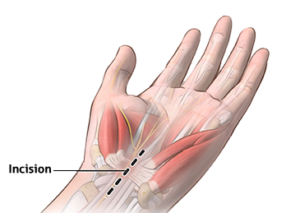Carpal Tunnel Release Surgery

It’s common for us to use our hands quite often without even thinking twice. However, if you have carpal tunnel, the numbness, pain, and tingling will most definitely get your attention! And although its common to treat carpal tunnel with just a brace or cortisone injections, surgery is an option for severe cases.
Carpal tunnel syndrome is caused by pressure on your median nerve. When you experience carpal tunnel symptoms, it is due to the median nerve being pinched or squeezed.
Surgery is actually quite common for carpal tunnel. It is a quick procedure with minimal downtime and the pain relief is quite instant.
It’s most common for physicians to request carpal tunnel release surgery, when:
- Treatments such as braces, corticosteroids, and changes to your daily routine haven’t helped.
- Your pain, numbness, and tingling don’t subside within 6-months.
- It’s hard to grip, grasp, or pinch objects like you once did.
Carpal Tunnel Release Surgical Options:
First off, there are two main types of procedures, open or endoscopic. And in either case, your doctor will cut the ligament around the tunnel. Therefore, relieving pressure off of the median nerve. After pressure is removed from the median nerve, symptoms are relieved. Once the surgery has been performed, your ligaments will re-attach themselves. But with more room for the nerve to pass through.
Open Surgery: This procedure involves an incision up to two inches, from your wrist to your palm.
Endoscopic Surgery: is performed when your surgeon makes a small incision in your wrist. Unlike the open surgery, this cut is only about 1/2 an inch wide. A tiny camera is then placed into the opening to guide the doctor as he releases the ligament.
Since the opening is smaller in the endoscopic surgery, the wound will most likely heal faster than the open procedure and therefore, involve less pain. Each situation is different and may require one over the other, ask your surgeon which is best for you.
What Will the Procedure Be Like?
Anesthesia is first administered to numb the wrist and hand. Some physicians prefer medicine to help calm the patient. General anesthesia is most common with this surgery, meaning you will be asleep during the procedure.
After the surgeon cuts the ligament, he/she will then stitch up your incision and place a bandage on your wrist. It’s common to be sent home the same day after the procedure. Overnight stays are uncommon and rarely occur.
Healing Process after Carpal Tunnel Release Surgery
Some patients have reported same-day relief after surgery. Although healing takes longer. Pain, swelling, and stiffness are common after the operation. Your physician will likely prescribe pain relievers. Up to a few weeks after surgery, you might have soreness. The bandage typically stays on for a couple of weeks.
It’s common for the patient to be recommended to lightly use their hand the first two weeks after the procedure. And you can even ask your doctor for exercises, to keep your wrist from getting stiff!
After a couple of days, you will be released to drive again. In about a week, you will be able to write. However, keep in mind it will take 4-6 weeks for it to feel completely normal. And then, 6-8 weeks out pulling, gripping and pinching, but lightly. Then, around weeks 10-12 your full strength will begin to return.
If you are experiencing the carpal tunnel and would like to speak to a wrist specialist about treatment options, call us at 888-409-8006.
